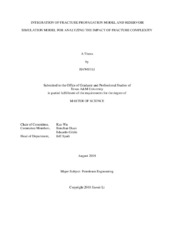| dc.description.abstract | Simulation of the impact of hydraulic fracture geometry on well performance has become significantly important for unconventional reservoir development recently. In most literatures, simple bi-wing-fracture pattern is assumed due to the difficulty and uncertainty in predicting the fracture geometry. However, bi-wing-fracture pattern does not agree with complex-fracture geometry in the way they influence reservoir behaviors. In this study, an integration framework of fracture propagation and reservoir simulation models has been developed to analyze the impact of complex-fracture and simple bi-wing-fracture pattern on well productivity and subsequent activities of enhancement hydrocarbon recovery.
First, an in-house fracture-propagation model is used to predict the complex hydraulic fracture geometry by considering elastic deformation of the rock and fluid flow. Then, the predicted fracture geometry is automatically read and transferred to a reservoir simulator through the embedded discrete fracture model (EDFM). In EDFM, the reservoir is discretized with structured gridding and additional grids are introduced for fractures. Each fracture plane is embedded inside matrix grid and is discretized by cell boundaries. Through non-neighboring connections, the EDFM can properly handle complex fracture geometries by modifying transmissibility.
The integrated model is applied to investigate the effect of complex fracture networks in Eagle Ford reservoir. The complex-fracture geometry is predicted by the fracture propagation model and calibrated by diagnostic data. Then the fracture parameters are processed with EDFM and transferred to numerical simulator. First, the history match results of different numerical cases with different complexity of fracture networks are compared. The oil flow rates are used as input
iii
data and we history match the bottom-hole pressure, gas flow rate and water flow rate. Simulation results show that higher fracture conductivity is required for bi-wing-fracture case compared with complex-fracture case to match the field data. Further, complex-fracture network can better capture the pressure drop in transient state. Then, the effects of fracture complexity on long term production and wettability alteration are investigated. The results confirms that complex fracture networks does not agree with the simple bi-wing fracture networks the way they influence reservoir behavior and wettability alteration. Additionally, the impact of natural fractures on the wettability alteration is investigated. The results indicate that the existence of natural fractures significantly amplifies the effect of wettability alteration and vice versa.
The EDFM in this paper efficiently transfers the fracture propagation model results to a reservoir simulator, making it possible oil industry to effectively simulate the entire scenario from hydraulic fracturing to the production process. Moreover, this paper explains how different it is the way the complex-fracture networks and simple-fracture networks influence the reservoir behavior, which gives us more understanding in complex-fracture-network simulation and provides useful guide in well optimization and fracture treatment design. | en |


